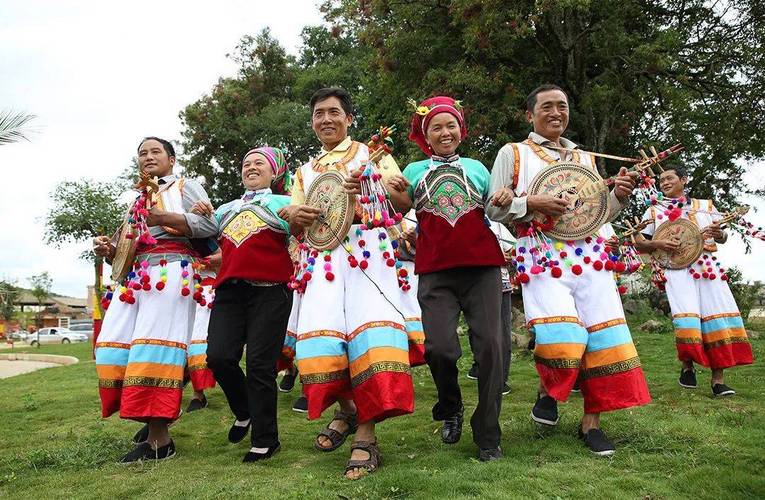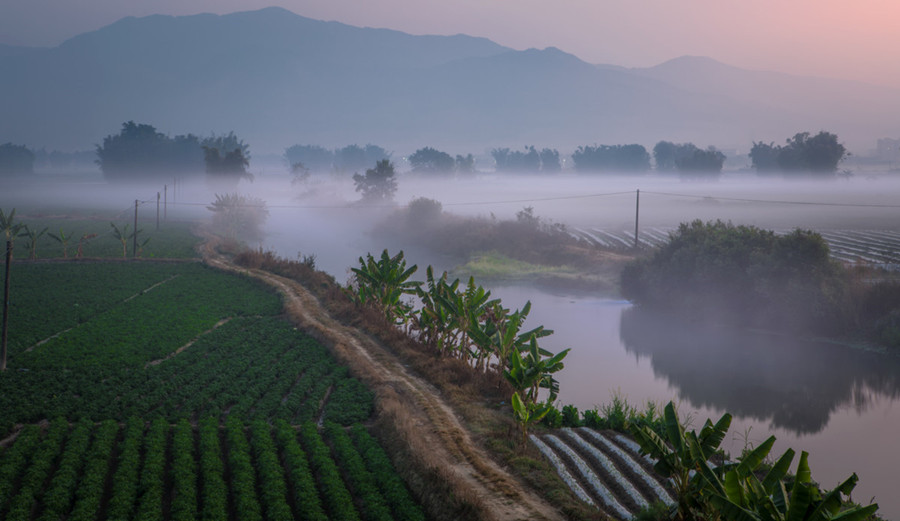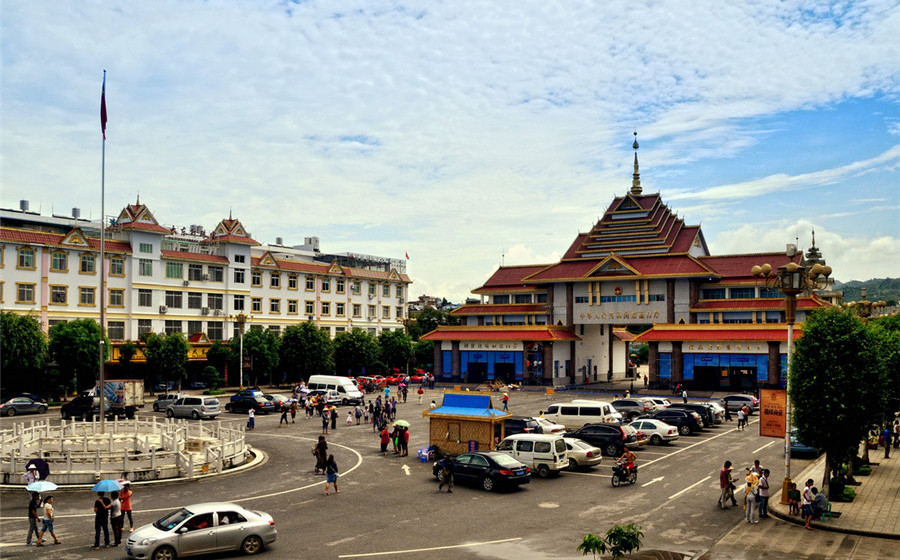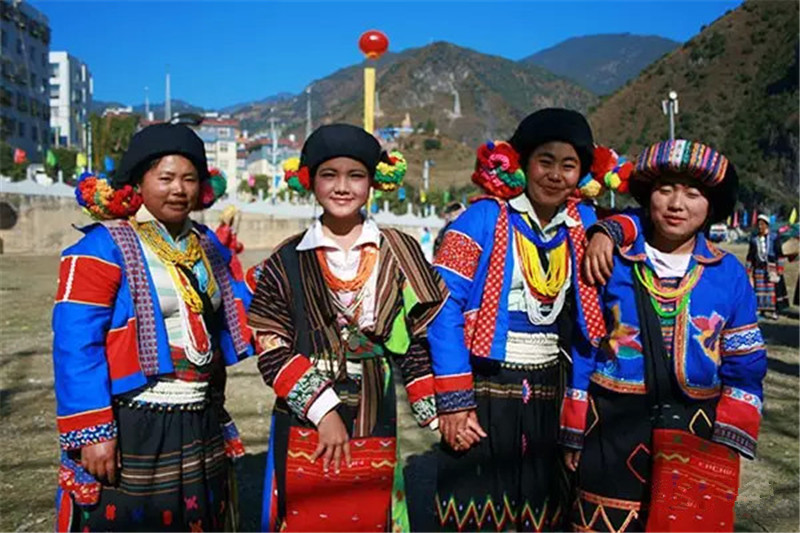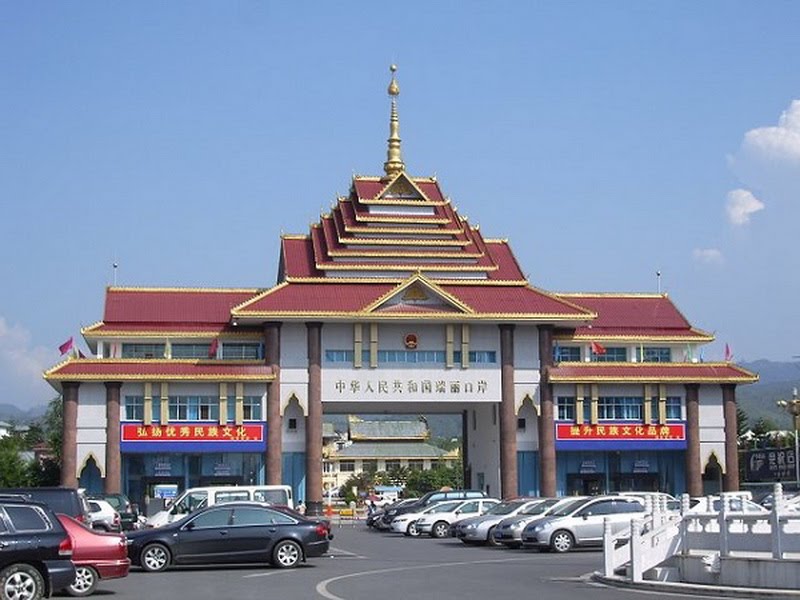
Dehong Overview
Dehong Overview will give you a comprehensive understanding of Dehong Dai and Jingpo Autonomous Prefecture including the basic information, geographical location, climate, transportation and so on.
Basic Information
- Chinese Name: 德宏傣族景颇族自治州
- Area: 11500 square kilometers
- Population: 1,211,000
- Zip code: 678400
- Dialing code: (+86) 0692
- Location: Sino-Burma border
- Administrative Category: Autonomous Prefecture
- Seat of Government: Mangshi City
- Main Ethnic Groups: Dai, Jingpo, Lisu, Achang and Deang
- Language: Dai Dialect, Jingpo Dialect, Southwestern Mandarin
- Main Airport:Mangshi Airport
- Main College: Dehong Normal College
- Important Festival and Activities: Water Splashing Festival , Munao Zongge Festival , Kuoshi Festival ,Aluwoluo Festival
- Famous Attractions: Mangling One Tree Forest, Moli Tropical Rainfores , Ruili River , Menghuan Golden Pagoda,Dadenghan Dai Village ,Moli Waterfall
Brief Introduction of Dehong
Dehong Dai and Jingpo Autonomous Prefecture is known as the Peacock Town which is located in the west of Yunnan. Dehong is a transliteration from Dai language, meaning ‘the downstream of the Nujiang River’. Dehong Prefecture boasts distinctive geological advantages. It shares a 503.8 km border with Burma. Four of the five Dehong’s counties lie on the border.Historically, Dehong Prefecture was a major outpost of the ancient Silk Road. Nowadays, Dehong Prefecture is the juncture for the Chinese Economic Area, Southeast Economic Area and South Asia Economic Area. Dehong is the fascinating place where the Dai and Jingpo people as well as other ethnic groups live harmoniously. It offers the charming natural scenery and the superior climatic conditions. Local people forget the hustle and bustle of the city, enjoy the nature and appreciate the minority customs.
History of Dehong
Dehong was called “Ancient Mengmao Kingdom” in the recording of The Pattra Sutra; it was named as the “Dianyue Elephant Riding Kingdom” under the pen of Simaqian; it was the Jinchi Kingdom in the book of “Marcopolo and His Travels”. Dehong is not only the outlet of the ancient “The Southwest Silk Road of China”, but also the outlet of the Yunnan-Myanmar Road. At present,it is still the golden port leading to South Asia and Southeast Asia. Since its founding in 1953, the Dehong Dai and Jingpo Autonomous Prefecture has been a great concern of the leaders of the CPC Central Committee and the State Council. The older generation of the Party and state leaders such as Mao Zedong, Liu Shaoqi, Zhou Enlai concerns the troops stationed in border areas, cadres and the people of all nationalities. Whatever, different ethnic groups live in the pure land in harmony.
More about History of Dehong Dai and Jingpo Autonomous Prefecture
Geography
Dehong is located in the southern part of the Hengduan Mountains in the west of Yunnan Guizhou Plateau. The western mountains of Gaoligong Mountains extend into Dehong.The highest point in the whole prefecture is 3404.6 meters in the Dangniang mountain in the north of the Yingjiang River, and the lowest point in the Jieyang Valley in the west of Yingjiang, only 210 meters above sea level. The state is generally 800 - 2100 meters above sea level.
Situated in the west boundary area of Yunnan Province, Dehong Dai and Jingpo Autonomous Prefecture neighbors Baoshan City to the east and northeast, and shares a boundary of 504 kilometers (313 miles) with Burma in the south, west and northwest. “Dehong” in Dai language means the lower reaches of Nujiang River, and its total area is 11526 m2. The national-level scenic zone of Ruilijiang River and Dayingjiang River sweeps into almost the whole prefectural land area; in its subordinated three counties and two cities, there are two excellent tourism cities, Ruili City and Yingjiang County.
Climate and Weather
Dehong Prefecture is close to the Tropic of Cancer, located at a low latitude and affected by the southwest monsoon of the Indian Ocean, which belongs to the south subtropical monsoon climate. In summer, warm and humid air from the Indian Ocean rises along the windward slope of the southwest sloping mountain, forming abundant natural precipitation. In addition, the low latitude plateau region has a large incidence angle of the sun and good air transparency, making it one of the high-quality illumination areas in the country.
The Best Time to Visit Dehong
The best time to visit Dehong is from September to May next year. September to May next year is the best time to travel to Dehong. You can not only avoid the hot and humid rainy season in Dehong, but also stay away from the cold and long winter in the north. You can enjoy the colorful customs of southwest ethnic minorities in the subtropical beautiful scenery in spring-like seasons.
Administrative Division
Dehong Adminstrative Division gives you information about places to visit when you travel to Dehong. Dehong Dai and Jingpo Autonomous Prefecture covers 2 cities and 3 counties. Its government seat is located in Mangshi City.
2 Cities
- Mangshi City 芒市
- Ruili City 瑞丽市
3 Counties
- Longchuan County 陇川县
- Lianghe County 梁河县
- Yingjiang County 盈江县
Dehong Culture
Local culture emphasizes on the minority culture and Hinayana Buddhist culture in Dehong, which make Dehong colorful and interesting. The literature and art in Dehong are fantastic, covering the drama, music, dancing and handicrafts. All of these show the booming culture of Dehong. There is one point which should be remarked in Dehong. That is the strong belief in Hinayana Buddhism represented in the forest of pagodas and temples. Local culture of Dehong is the integration of diverse ethnic culture.
More about Dehong Culture
Dehong Transportation
The transportation of Dehong is convenient in general. There are long-distance buses and airlines (Mangshi Airport) from Kunming to Dehong. The railway station is being built. It is also convenient to get around in Dehong. Dehong Prefecture boasts distinctive geological advantages. It shares a 503.8 km border with Burma. Four of the five Dehong's counties lie on the border. There are 28 ferries, 64 passages and 9 highways that lead to Burma. Historically, Dehong Prefecture was a major outpost of the ancient Silk Road. Nowadays, Dehong Prefecture is the juncture for the Chinese Economic Area, Southeast Economic Area and South Asia Economic Area.
More about Dehong Transportation
Things to Do in Dehong
Dehong travel features in tropical rain forest scenery, ethnic culture, border culture and Jade Culture Tour. If you want to have an overall glimpse into all facades of Dehong, at least 3 days are suggested for Dehong travel.
Tropical Rain Forest Tour
The natural beauty of the region is prominently rendered by the Ruili and Da’ying Rivers which have allowed the thriving flora and fauna, natural scenes and ethnic cultures to thrive. Birding tour to Yingjiang Hornbill Valley and hiking to Moli Tropical Rainforest and Moli Waterfall or Drifting on Ruili River will feast your eyes with the pleasant tropical rain forest scenery.
Religion Culture Tour
However the tropical rain forest scenery is not the only attraction of this beautiful area. The Dai people in Dehong believe in Theravada Buddhism and there are stupas spread across the prefecture. Two of them are clearly unique. They are called Tree-Wrapped Pagoda and Pagoda-Wrapped Tree. As the name suggests, the former has a banyan tree wrapped around it and the latter has been built around a tree. It is believed that this has been a natural occurrence and not induced by disciples. If you want to know about the Theravada Buddhism and the architecture art of Dai temples and pagodas, you shouldn’t miss the temples in Dehong, particularly the famous ones such as Yunyan Stupa , Jiele Great Golden Pagoda, Menghuan Golden Pagoda.
Munao Zongge Dance Festival
If you visit Dehong in February, you will be able to attend the Munao Zongge Dance Festival which is the grandest celebration of the Jingpo ethnic minority that lasts for three days and falls on the 15th day of the first lunar calendar. Dancing is the main highlight of the festival, you can watch Jingpo people dancing in their folk costumes, with silver ornaments shining and jangling. At the end of the dancing show, all participant are invited in join in the dance, you should have a try.
Jade Discovery & Border Culture
Ruili, take its location advantage for adjacent Burma, is one of the most important trade center of emeralds in China. Large quantity of top-qualitied emeralds has enticed many tourists or buyer from Beijing, Shanghai or Hongkong. Ruili also gained the praise as “Emeralds of Yunnan, Emeralds from Ruili”. Mangshi has some jade wholesale market. Because it’s closed to Burma where it has rich jade and stone resource, with good quality and reasonable price. Ruili Tourist Jewelry Street, Jiegao Jade Town in Ruili City, Mangshi Jewelry Town have the fine collection of jade and jewelry products for you choice. You may also experience finding gemstones in the Taobaochang in Nangu River, or try a small gamble on stone in Dehong Jewelry Night Market 德龙珠宝夜市.
Read More:
- Dehong Hiking Tours
- Dehong Birding Tours
- Dehong Cycling Tours
- Dehong Muslim Tours
- Dehong Adoption Heritage Tours
- Dehong Tea Culture Tours
Dehong Economy
In 2016, the state's GDP will reach 32.099 billion yuan, up 9.4% over the previous year. Among them, the added value of the primary industry reached 7.805 billion yuan, up 5.6%, driving the GDP growth by 1.4 percentage points. The added value of the secondary industry reached 7.906 billion yuan, up 13.3%, pushing up the GDP by 3.3 percentage points. The added value of the tertiary industry reached 16.388 billion yuan, up 9.3%, pushing up the GDP by 4.7 percentage points. The contribution rates of primary, secondary and tertiary industries to the overall economy were 15.0%, 35.0% and 50.0%, respectively. The tertiary industry structure changed from 25.1: 24.6: 50.3 to 24.3:24.6:51.1 last year. Per capita GDP reached 24951 yuan, up 1961 yuan, up 8.1%. The added value of the non-public economy was 15.406 billion yuan, accounting for 48.0% of the state's GDP.
Natural Resources in Dehong
Water Resources
The average annual water output of rivers in Dehong Prefecture is 13.63 billion cubic meters, and the transit water volume is 8.17 billion cubic meters. The total amount of water resources is 21.8 billion cubic meters, most of the surface water is not polluted, and the physical properties are good, meeting the requirements of industrial and agricultural production and domestic water. Dehong's utilization rate of water resources accounts for only 2.3% of its total. The theoretical reserve of water energy is 3.624 million kilowatts, of which 1.0215 million kilowatts can be developed and utilized.
Mineral Resources
There are more than 20 kinds of proven mineral resources in Dehong. Non-ferrous metals include tin, lead, zinc, copper, tungsten, chromium and nickel, ferrous metals include iron, energy minerals include coal and petroleum, rare metals include beryllium, uranium, germanium and clay, special nonmetals, building materials and other nonmetal minerals include mica, crystal, gem and limestone. In addition, Dehong also boasts 10 abnormal zones of heavy placer gold. Dehong mineral resources are characterized by diverse types, less reserves and less mining.
Plant Resources
Forests are distributed in different climatic zones: tropical and northern subtropics monsoon climate, accounting for 5.4% of the total forest area in Dehong. The main vegetation is Dipterocarp, Assam Salar, teak, Mayterus Hookeri Loes, hawthorn, bamboo, etc. In subtropics, the main vegetation is broad-leaved forest, mainly composed of Castanopsis hystrix, Quercus, Castanopsis fargesii, Schima superba, Ailanthus altissima, nanmu, teak, Camellia oleifera and pine, accounting for 57.2% of the total area. In the warm zone, the main vegetation is evergreen broad-leaved forest, fir, pine, camellia and walnut, accounting for 36.1%. In temperate mountainous regions, the rated vegetation is hemlock, Quercus acutissima, rhododendron bush, etc., accounting for about 1.3%. In addition, Yunnan's large-leaf tea species is planted all over the prefecture, and Dehong small-grain coffee is famous in the world for its good taste and quality.
Animal Resources
As of the end of 2013, there are a class of protected animals stipulated by the state: green peacock, peacock pheasant, white cheek partridge, red-legged kestrel, black-necked long-tailed pheasant, red-necked crane, red-bellied tragopan, etc. The animals listed to the second -class national protection species include: grass osprey (monkey-faced eagle), original chicken, turtledove, bamboo woodpecker, pangolin, etc. According to incomplete investigation, there are 554 vertebrates in Yingjiang County alone, including 56 fishes, 22 amphibians, 34 reptiles, 356 birds and 86 mammals.
Regional Overview
- Ruili Overview
- Mangshi Overview
- Yingjiang County Overview
- Longchuan County Overview
- Lianghe County Overview
Keep Reading

 7 Days GolfingTour
7 Days GolfingTour
 8 Days Group Tour
8 Days Group Tour
 8 Days Yunnan Tour
8 Days Yunnan Tour
 7 Days Shangri La Hiking
7 Days Shangri La Hiking
 11 Days Yunnan Tour
11 Days Yunnan Tour
 6 Days Yuanyang Terraces
6 Days Yuanyang Terraces
 11 Days Yunnan Tour
11 Days Yunnan Tour
 8 Days South Yunnan
8 Days South Yunnan
 7 Days Tea Tour
7 Days Tea Tour
 8 Days Muslim Tour
8 Days Muslim Tour
 12 Days Self-Driving
12 Days Self-Driving
 4 Days Haba Climbing
4 Days Haba Climbing
 Tiger Leaping Gorge
Tiger Leaping Gorge
 Stone Forest
Stone Forest
 Yunnan-Tibet
Yunnan-Tibet
 Hani Rice Terraces
Hani Rice Terraces
 Kunming
Kunming
 Lijiang
Lijiang
 Shangri-la
Shangri-la
 Dali
Dali
 XishuangBanna
XishuangBanna
 Honghe
Honghe
 Kunming
Kunming
 Lijiang
Lijiang
 Shangri-la
Shangri-la
 Yuanyang Rice Terraces
Yuanyang Rice Terraces
 Nujiang
Nujiang
 XishuangBanna
XishuangBanna
 Spring City Golf
Spring City Golf
 Snow Mountain Golf
Snow Mountain Golf
 Stone Mountain Golf
Stone Mountain Golf
